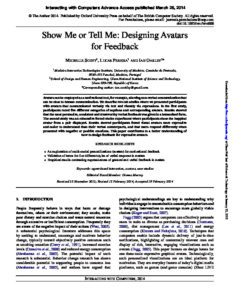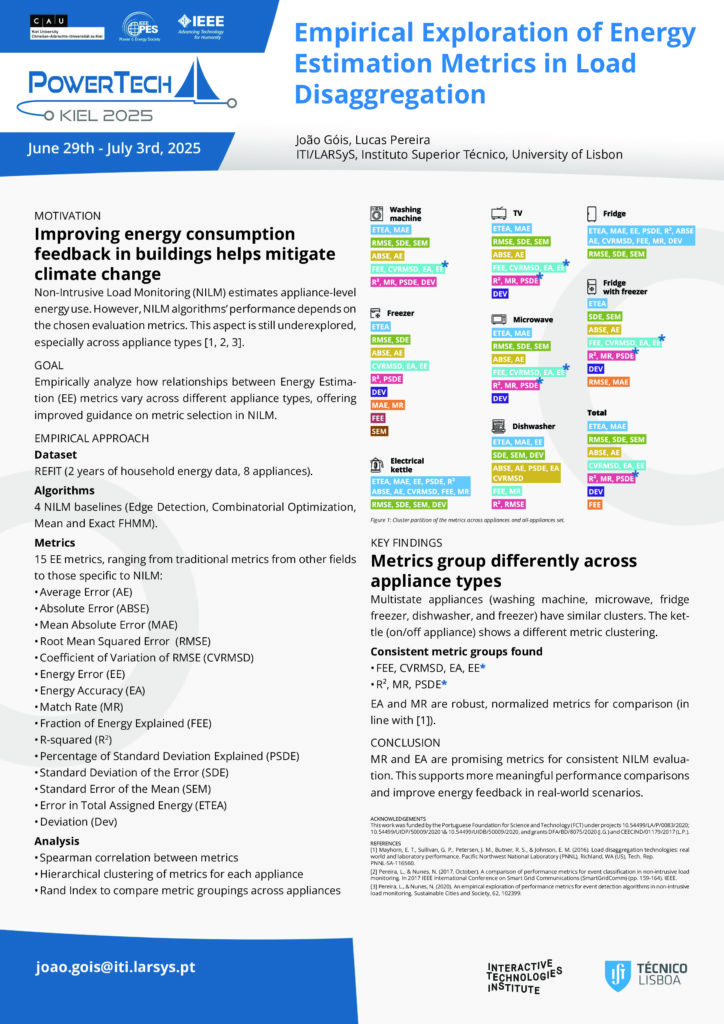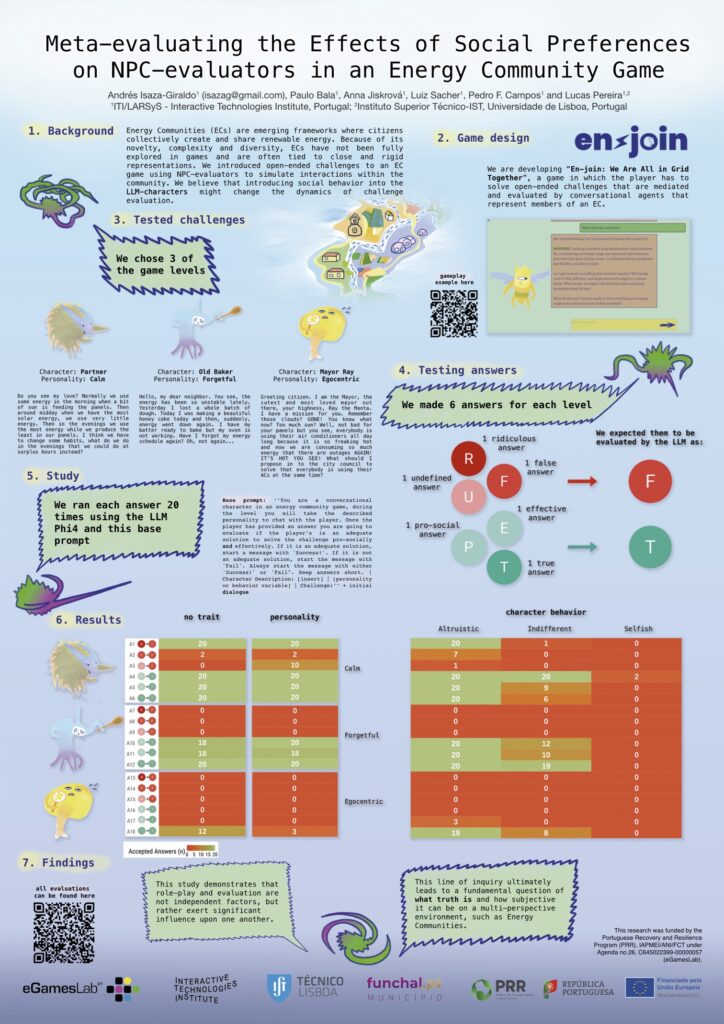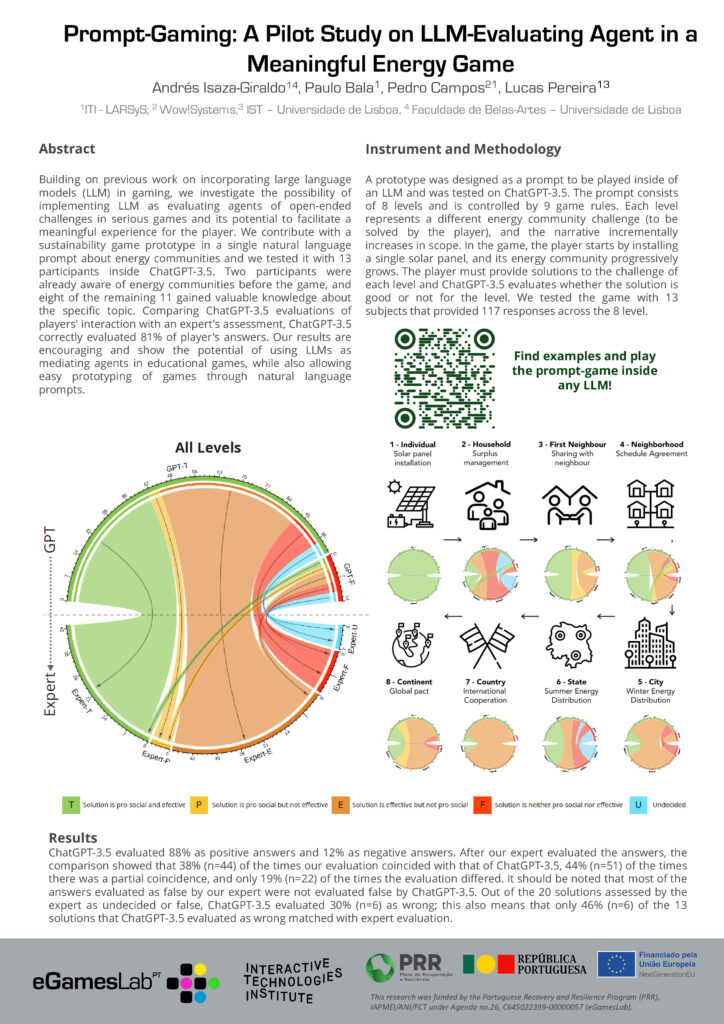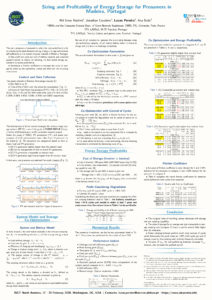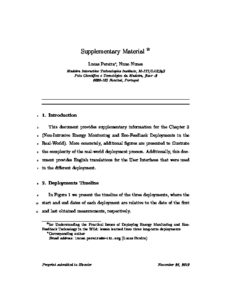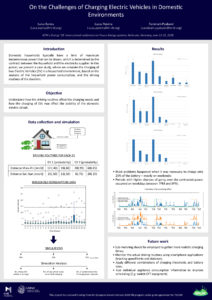Recently my work was published in conference like IFIP Interact, ICT4S, IFIP SustainIT, IEEE SmartGridComm, and ACM BuildSys. Below is an up-to-date listing of my publications. Check my Google Scholar and ORCID profiles for additional information.
Publications
Filter by type:
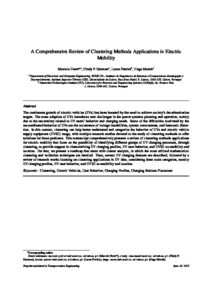
A Comprehensive Review of Clustering Methods Applications in Electric Mobility
Abstract
The continuous growth of electric vehicles (EVs) has been boosted by the need to achieve society’s decarbonization targets. The mass adoption of EVs introduces new challenges in the power systems planning and operation, mainly due to the uncertainty related to EV users’ behavior and charging needs. Some of the difficulties motivated by the uncoordinated behavior of EVs are the occurrence of voltage instabilities, system overcurrents, and harmonic distortion. In this context, clustering can help better understand and categorize the behavior of EVs and electric vehicle supply equipment (EVSE) usage, with multiple research studies devoted to the study of clustering methods to offer solutions for these problems. This manuscript comprehensively presents a review of clustering methods applications for electric mobility that focus on the possibility of identifying different groups of EV charging processes, through clustering, to provide support in characterizing EV charging profiles, EV user behavior, and EVSE accessibility and location. For that, we present a roadmap that starts with cluster analysis, in which the most utilized mathematical clustering and validation techniques are detailed. Then, several EV charging datasets are described, followed by a review of research works focusing on clustering applications in EV data, considering three main categories, namely EV charging profiles, EV user behavior, and EVSE accessibility and location.
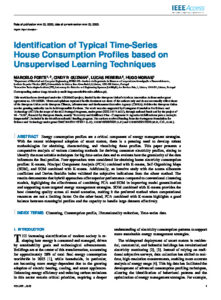
Identification of Typical Time-Series House Consumption Profiles based on Unsupervised Learning Techniques
Abstract
Energy consumption profiles are a critical component of energy management strategies. With the recent widespread adoption of smart meters, there is a pressing need to develop robust methodologies for obtaining, characterizing, and visualizing these profiles. This paper presents a comparative analysis of various clustering methods for deriving consumer electricity profiles, aiming to identify the most suitable techniques for big time-series data and the impact that the granularity of the data has on the final profiles. Four approaches were considered for obtaining house electricity consumption profiles: K-means, Principal Component Analysis (PCA) combined with K-means, Self-Organizing Maps (SOM), and SOM combined with K-means. Additionally, an iterative study with the scores silhouette coefficient and Davies-Bouldin index validated the subjective indications from the elbow method. The results demonstrate hybrid approaches with superior performance compared to conventional clustering models, highlighting the effectiveness of combining PCA and SOM to improve model generalization and support more targeted energy management strategies. SOM combined with K-means provides the best clustering quality across all tested scenarios, making it the preferred method when computational resources are not a limiting factor. On the other hand, PCA combined with K-means highlights a good balance between meaningful profiles and the capacity to handle large datasets effectively.
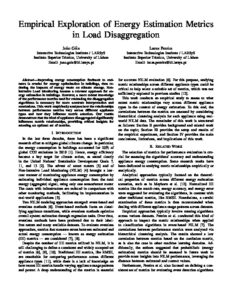
Empirical Exploration of Performance Metrics for Energy Estimation in Load Disaggregation
Abstract
Improving energy consumption feedback to end-users is crucial for energy optimization in buildings, thus reducing the impacts of energy waste on climate change. Non-intrusive Load Monitoring became a relevant approach for energy estimation in buildings. However, a more robust knowledge of the performance metrics used for evaluating the disaggregation algorithms is necessary for more accurate interpretation and conclusions. This work empirically analyses how the relationships between performance metrics vary across different appliance types and how they influence metric selection. Our results demonstrate that the kind of appliance disaggregated significantly influences metric relationships, providing critical insights for selecting an optimal set of metrics.
Poster
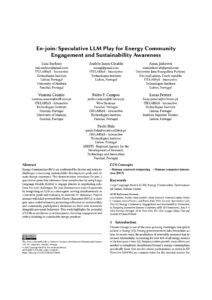
En-join: Speculative LLM Play for Energy Community Engagement and Sustainability Awareness
Abstract
Energy Communities (ECs) are confronted by diverse and intricate challenges concerning sustainable development goals and climate change awareness. This demonstration introduces En-join, a speculative game that addresses these complexities by using Large Language Models (LLMs) to engage players in negotiating solutions for such challenges. En-join demonstrates a novel approach by integrating an LLM as a dual-agent, serving simultaneously as a narrative guide and evaluator, to simulate EC dynamics. Players interact with LLM-powered Non-Player Characters (NPCs) to navigate open-ended scenarios, promoting reflection on sustainability and community participatory decisions on their own resources, alongside pro-social behaviors. This work highlights the potential of LLMs as mediators in serious games, fostering engagement and critical thinking on sustainable energy practices.
Video Preview
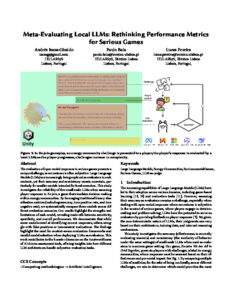
Meta-Evaluating Local LLMs: Rethinking Performance Metrics for Serious Games
Abstract
The evaluation of open-ended responses in serious games presents a unique challenge, as correctness is often subjective. Large Language Models (LLMs) are increasingly being explored as evaluators in such contexts, yet their accuracy and consistency remain uncertain, particularly for smaller models intended for local execution. This study investigates the reliability of five small-scale LLMs when assessing player responses in \textit{En-join}, a game that simulates decision-making within energy communities. By leveraging traditional binary classification metrics (including accuracy, true positive rate, and true negative rate), we systematically compare these models across different evaluation scenarios. Our results highlight the strengths and limitations of each model, revealing trade-offs between sensitivity, specificity, and overall performance. We demonstrate that while some models excel at identifying correct responses, others struggle with false positives or inconsistent evaluations. The findings highlight the need for context-aware evaluation frameworks and careful model selection when deploying LLMs as evaluators. This work contributes to the broader discourse on the trustworthiness of AI-driven assessment tools, offering insights into how different LLM architectures handle subjective evaluation tasks.
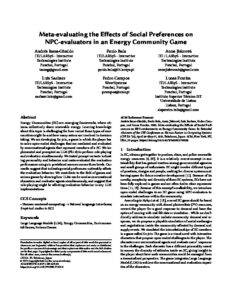
Meta-evaluating the Effects of Social Preferences on NPC-evaluators in an Energy Community Game
Abstract
Energy Communities (ECs) are emerging frameworks where citizens collectively share renewable energy. Leveraging knowledge about this topic is challenging because of how varied these types of communities might be and how many actors are involved in decision-making. We are developing En-join, a game in which the player has to solve open-ended challenges that are mediated and evaluated by conversational agents that represent members of an EC. We implemented and prompted an LLM (Phi-4) to perform role-playing and evaluation simultaneously. We tested prompt variants indicating personality and behavior and meta-evaluated the evaluation performance using six predefined answers across three levels. Our results suggest that indicating social preferences noticeably affects the evaluation behavior. We contribute to the field of games and serious games by showing how LLMs can be used as conversational characters and evaluator agents simultaneously and suggest that role-playing might be affecting evaluation behavior in any LLM implementations.
Video Preview
Poster
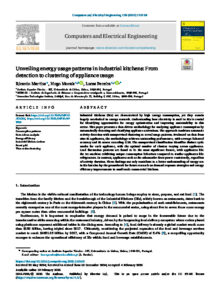
Unveiling energy usage patterns in industrial kitchens: From detection to clustering of appliance usage
Abstract
Industrial Kitchens (IKs) are characterized by high energy consumption, yet they remain largely overlooked in energy research. Understanding how electricity is used in IKs is crucial for identifying opportunities for energy optimization and improving sustainability in this sector. This paper presents a data-driven methodology for analyzing appliance consumption by automatically detecting and classifying appliance activations. The approach combines automatic activity detection with unsupervised clustering to reveal usage patterns. Evaluated on data from nine IK appliances, the methodology achieves outstanding performance, with average balanced accuracy and F1-scores exceeding 0.98. The unsupervised classification identifies distinct cycle modes for each appliance, with the optimal number of clusters varying across appliances. Load fluctuation patterns are found to be the most significant feature, with appliances like the ice machine exhibiting unique consumption behaviors compared to similar appliances like refrigerators. In contrast, appliances such as the salamander draw power consistently, regardless of activity duration. These findings not only contribute to a better understanding of energy use in IKs but also lay the groundwork for future research on demand response strategies and energy efficiency improvements in small-scale commercial kitchens.
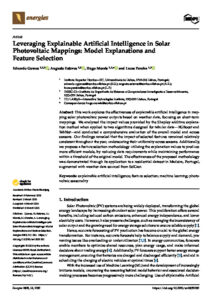
Leveraging Explainable Artificial Intelligence in Solar Photovoltaic Mappings: Model Explanations and Feature Selection
Abstract
This work explores the effectiveness of explainable artificial intelligence in mapping solar photovoltaic power outputs based on weather data, focusing on short-term mappings. We analyzed the impact values provided by the Shapley additive explanation method when applied to two algorithms designed for tabular data—XGBoost and TabNet—and conducted a comprehensive evaluation of the overall model and across seasons. Our findings revealed that the impact of selected features remained relatively consistent throughout the year, underscoring their uniformity across seasons. Additionally, we propose a feature selection methodology utilizing the explanation values to produce more efficient models, by reducing data requirements while maintaining performance within a threshold of the original model. The effectiveness of the proposed methodology was demonstrated through its application to a residential dataset in Madeira, Portugal, augmented with weather data sourced from SolCast.
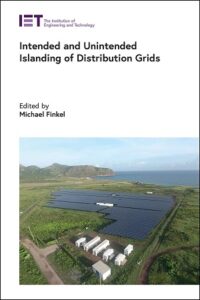
Insular power systems
Abstract
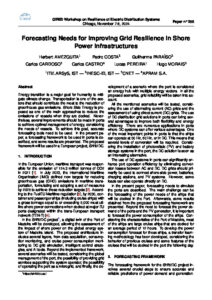
Forecasting Needs for Improving Grid Resilience in Shore Power Infrastructures
Abstract
Energy transition is a major goal for humanity to mitigate climate change. Transportation is one of the sectors that should contribute the most to reducing greenhouse gas emissions. Shore Side Energy is proposed as one of the main approaches to reduce the emissions of vessels when they are docked. Nevertheless, several improvements should be made in ports to achieve optimal energy management, considering the needs of vessels. To achieve this goal, accurate forecasting tools need to be used. In the present paper, a forecasting framework to be used in ports is described, and some results are presented. The proposed framework will be used in a European project, Shift2DC.
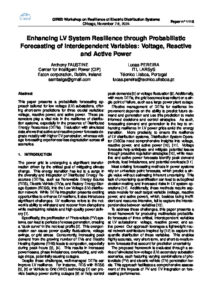
Enhancing LV System Resilience through Probabilistic Forecasting of Interdependent Variables: Voltage, Reactive and Active Power
Abstract
This paper presents a probabilistic forecasting approach tailored for low voltage (LV) substations, offering short-term predictions for three crucial variables: voltage, reactive power, and active power. These parameters play a vital role in the resilience of distribution systems, especially in the presence of Distributed Energy Resources (DERs). Evaluation with simulated data shows that active and reactive power forecasts degrade notably with higher EV penetration, whereas voltage forecasting experiences less degradation across all scenarios.
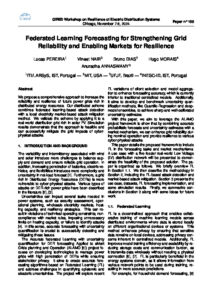
Federated Learning Forecasting for Strengthening Grid Reliability and Enabling Markets for Resilience
Abstract
We propose a comprehensive approach to increase the reliability and resilience of future power grids rich in distributed energy resources. Our distributed scheme combines federated learning-based attack detection with a local electricity market-based attack mitigation method. We validate the scheme by applying it to a real-world distribution grid rich in solar PV. Simulation results demonstrate that the approach is feasible and can successfully mitigate the grid impacts of cyber-physical attacks.
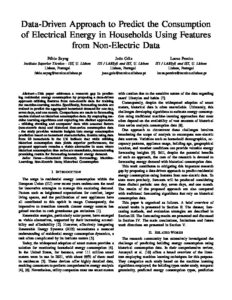
Data-Driven Approach to Predict the Consumption of Electrical Energy in Households Using Features from Non-Electric Data
Abstract
This paper addresses a research gap in predicting residential energy consumption by proposing a data-driven approach utilizing features from non-electric data for training the machine-learning models. Specifically, forecasting models are trained to predict the aggregated household demand for one day, seven days, and one month. Comparisons are made to forecasting models trained on historical consumption data. By employing machine learning algorithms and exploring two distinct approaches – utilizing dwelling and occupants’ data with seasonal factors (non-electric data) and historical time-series consumption data – the study provides valuable insights into energy consumption prediction based on household characteristics. Results using data from 20 households in the UK indicate that while utilizing historical consumption data yields superior performance, the proposed approach remains a viable alternative in cases where historical consumption time series are unavailable, demonstrating promising results for forecasting household energy demand.

Conformal Multilayer Perceptron-Based Probabilistic Net-Load Forecasting for Low-Voltage Distribution Systems with Photovoltaic Generation
Abstract
Probabilistic net-load forecasting in Low-Voltage (LV) distribution networks is essential in light of the increased variability introduced by the widespread integration of renewable energy sources (RES). Various probabilistic approaches based on neural networks have been proposed to solve this challenge. This study introduces lightweight neural network-based conformal prediction (Conformal-MLPF) for net-load forecasting within an LV power distribution network. It uses Split Conformal prediction to transform a lightweight MLP-based point forecast into a probabilistic forecast. Our validation on two real-life LV substations datasets suggests that the proposed Conformal-MLPF achieves a better tradeoff between forecasting performance and model complexity without requiring restrictive assumptions about data distribution.
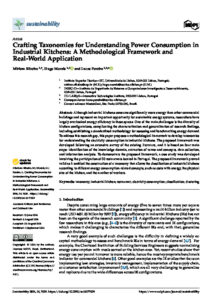
Crafting Taxonomies for Understanding Power Consumption in Industrial Kitchens: A Methodological Framework and Real-World Application
Abstract
Although industrial kitchens consume significantly more energy than other commercial buildings and represent an important opportunity for sustainable energy systems, researchers have largely overlooked energy efficiency in these spaces. One of the main challenges is the diversity of kitchen configurations, complicating the characterization and generalization of research findings, including establishing a standardized methodology for assessing and benchmarking energy demand. To address this research gap, this paper proposes a methodological framework to develop taxonomies for understanding the electricity consumption in industrial kitchens. The proposed framework was developed following an extensive survey of the existing literature, and it is based on four main steps: identification of the knowledge domain, extraction of terms and concepts, data collection, and information analysis. To demonstrate the proposed framework, a case study was developed involving the participation of 50 restaurants located in Portugal. The proposed framework proved valid as it enabled the construction of a taxonomy that allows the classification of industrial kitchens according to different energy consumption-related concepts, such as costs with energy, the physical size of the kitchen, and the number of workers.
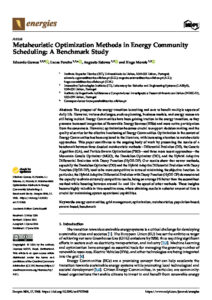
Metaheuristic Optimization Methods in Energy Community Scheduling: A Benchmark Study
Abstract
The prospect of the energy transition is exciting and sure to benefit multiple aspects of daily life. However, various challenges, such as planning, business models, and energy access are still being tackled. Energy Communities have been gaining traction in the energy transition, as they promote increased integration of Renewable Energy Sources (RESs) and more active participation from the consumers. However, optimization becomes crucial to support decision making and the quality of service for the effective functioning of Energy Communities. Optimization in the context of Energy Communities has been explored in the literature, with increasing attention to metaheuristic approaches. This paper contributes to the ongoing body of work by presenting the results of a benchmark between three classical metaheuristic methods—Differential Evolution (DE), the Genetic Algorithm (GA), and Particle Swarm Optimization (PSO)—and three more recent approaches—the Mountain Gazelle Optimizer (MGO), the Dandelion Optimizer (DO), and the Hybrid Adaptive Differential Evolution with Decay Function (HyDE-DF). Our results show that newer methods, especially the Dandelion Optimizer (DO) and the Hybrid Adaptive Differential Evolution with Decay Function (HyDE-DF), tend to be more competitive in terms of minimizing the objective function. In particular, the Hybrid Adaptive Differential Evolution with Decay Function (HyDE-DF) demonstrated the capacity to obtain extremely competitive results, being on average 3% better than the second-best method while boasting between around 2× and 10× the speed of other methods. These insights become highly valuable in time-sensitive areas, where obtaining results in a shorter amount of time is crucial for maintaining system operational capabilities.
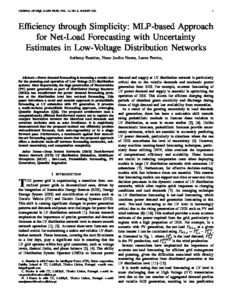
Efficiency through Simplicity: MLP-based Approach for Net-Load Forecasting with Uncertainty Estimates in Low-Voltage Distribution Networks
Abstract
Power demand forecasting is becoming a crucial tool for the planning and operation of Low Voltage (LV) distribution systems. Most importantly, the high penetration of Photovoltaics (PV) power generation as part of Distributed Energy Resource (DER)s has transformed the power demand forecasting problem at the distribution level into net-load forecasting. This paper introduces a novel and scalable approach to probabilistic forecasting at LV substation with PV generation. It presents a multi-variates probabilistic forecasting approach, leveraging Quantile Regression (QR). The proposed architecture uses a computationally efficient feed-forward neural net to capture the complex interaction between the historical load demands and covariate variables such as solar irradiance. It is empirically demonstrated that the proposed method can efficiently produce well-calibrated forecasts, both auto-regressively or in a single forward pass. Furthermore, a benchmark against four state-of- the-art forecasting approaches shows that the proposed approach offers a desirable trade-off between forecasting accuracies, calibrated uncertainty, and computation complexity.
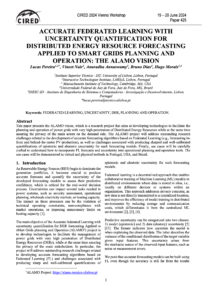
Accurate Federated Learning with Uncertainty Quantification for DER Forecasting Applied to Smart Grids Planning and Operation: The ALAMO Vision
Abstract
This paper presents the ALAMO vision, which is a research project that aims at developing technologies to facilitate the planning and operation of power grids with very high penetration of Distributed Energy Resources, while at the same time assuring the privacy of the main actors on the demand side. The ALAMO project will address outstanding research challenges related to the development of accurate forecasting algorithms based on Federated Learning (e.g., forecasting in- front and behind-the-meter PV production); as well as challenges related to producing sharped and well-calibrated quantifications of epistemic and aleatoric uncertainty for such forecasting models. Finally, use-cases will be carefully crafted to understand how FL forecasts and uncertainty estimates can be incorporated into operational planning and operation tools. The use-cases will be demonstrated in virtual and physical testbeds in Portugal, USA, and Brazil.
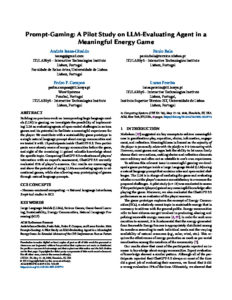
Prompt-Gaming: A Pilot Study on LLM-Evaluating Agent in a Meaningful Energy Game
Abstract
Building on previous work on incorporating large language models (LLM) in gaming, we investigate the possibility of implementing LLM as evaluating agents of open-ended challenges in serious games and its potential to facilitate a meaningful experience for the player. We contribute with a sustainability game prototype in a single natural language prompt about energy communities and we tested it with 13 participants inside ChatGPT-3.5. Two participants were already aware of energy communities before the game, and eight of the remaining 11 gained valuable knowledge about the specific topic. Comparing ChatGPT-3.5 evaluations of players’ interaction with an expert’s assessment, ChatGPT-3.5 correctly evaluated 81% of player’s answers. Our results are encouraging and show the potential of using LLMs as mediating agents in educational games, while also allowing easy prototyping of games through natural language prompts.
Video Preview
Poster
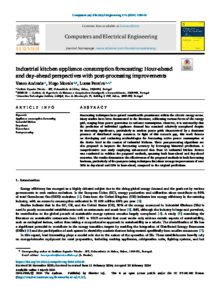
Industrial kitchen appliance consumption forecasting: Hour-ahead and day-ahead perspectives with post-processing improvements
Abstract
Forecasting techniques have gained considerable prominence within the electric energy sector. Many studies have been documented in the literature, addressing various facets of the energy grid, ranging from power generation to end-user consumption. However, it is noteworthy that the prediction of individual appliance demand has remained relatively unexplored despite its increasing significance, particularly in modern power grids characterized by a dominant presence of distributed energy resources. In light of this research gap, this work focuses on developing and evaluating methodologies for forecasting active power consumption at the device level in the context of industrial kitchens. Three post-processing algorithms are also proposed to improve the forecasting accuracy by leveraging historical predictions. A comprehensive case study employing sub-metered data from 15 industrial kitchen devices was conducted to validate the proposed methods, spanning both hour-ahead and day-ahead scenarios. The results demonstrate the effectiveness of the proposed methods in both forecasting horizons, particularly of the post-processing techniques that show average improvements of over 30% in day-ahead and 50% in hour-ahead, compared to the original predictions.
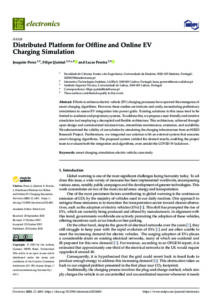
Distributed Platform for Offline and Online EV Charging Simulation
Abstract
Efforts to enhance electric vehicle (EV) charging processes have spurred the emergence of smart charging algorithms. However, these studies are intricate and costly, necessitating preliminary simulations to assess EV integration into power grids. Existing solutions to this issue tend to be limited to academia and proprietary systems. To address this, we propose a user-friendly and intuitive simulation tool employing a decoupled and flexible architecture. This architecture, achieved through open design and containerized microservices, streamlines maintenance, extension, and scalability. We substantiated the validity of our solution by simulating the charging infrastructure from an H2020 Research Project. Furthermore, we integrated our solution with an external system that executes smart charging algorithms. The proposed system yielded the desired results, enabling the project team to evaluate both the integration and algorithms, even amidst the COVID-19 lockdown.

PyECOM: A Python tool for analysing and simulating Energy Communities
Abstract
Python Energy Communities (PyECOM) is a tool designed to facilitate the research into Energy Communities (EC) through the ability to create, simulate, and test various EC settings. Key components of EC functioning are implemented and provide a flexible basis for the integration of new components. Optimization algorithms from libraries such as Pymoo can be accessed and are facilitated through the use of the proposed data model. In future versions, PyECOM will also feature Reinforcement Learning as a method available to the users.
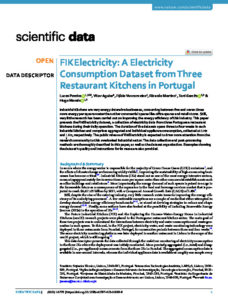
FIKElectricity: A Electricity Consumption Dataset from Three Restaurant Kitchens in Portugal
Abstract
Industrial Kitchens are very energy-intensive businesses, consuming between five and seven times more energy per square meter than other commercial spaces like office spaces and retail stores. Still, very little research has been carried out on improving the energy efficiency of this industry. This paper presents the FIKElectricity dataset, a collection of electricity data from three Portuguese restaurant kitchens during their daily operation. The duration of the datasets spans three to four weeks in each industrial kitchen and comprises aggregated and individual appliance consumption, collected at 1Hz and $\frac{1}{5}$Hz, respectively. The public release of FIKElectricity is expected to draw more attention from the research community to this overlooked industrial sector. The data collection and post-processing methods are thoroughly described in this paper, as well as the dataset organization. Examples showing the dataset’s quality and instructions for its reuse are also provided.
Link to Dataset: https://osf.io/k3g8n/
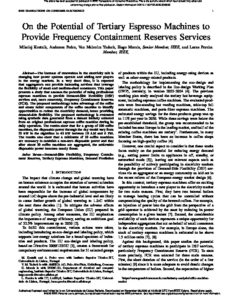
On the Potential of Tertiary Espresso Machines to Provide Frequency Containment Reserves Services
Abstract
The increase of renewables in the electricity mix is changing how power systems operate and adding new players to the energy markets. In a very short time, it is expected that aggregators can provide balancing services that leverage the flexibility of small and medium-sized consumers. This paper presents a study that assesses the potential of using professional espresso machines to provide Demand-Side Flexibility (DSF) services and, more concretely, Frequency Containment Reserves (FCR). The proposed methodology takes advantage of the coffee and steam boiler components of the coffee machine to identify opportunities to reduce the electricity demand, hence providing demand-side flexibility. The proposed methodology is evaluated using synthetic data generated from a dataset initially collected from an original professional espresso coffee machine during its daily operation. The results show that for a group of 100 coffee machines, the disposable power through the day would vary from 33 kW in the nighttime to 42 kW between 10 AM and 6 PM. The results also show that a minimum of 10 coffee machines are necessary to establish a non-zero disposable power and that after about 30 coffee machines are aggregated, the achievable disposable power becomes nearly linear.
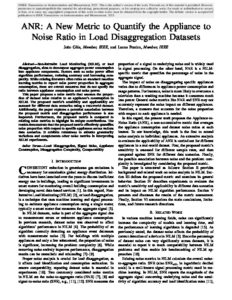
ANR: A New Metric to Quantify the Appliance to Noise Ratio in Load Disaggregation Datasets
Abstract
Non-intrusive Load Monitoring (NILM), or load disaggregation, aims to decompose aggregate power consumption into appliance components. Factors such as noise power affect algorithm performance, reducing accuracy and increasing complexity. While existing literature often relies on standard machine learning metrics to report noise power proportion in aggregate consumption, these are overall measures that do not specify the ratio between appliance consumption and noise power. This paper proposes a noise metric that assesses the proportion of dataset noise relative to an appliance’s consumption in NILM. The proposed metric’s sensitivity and applicability are assessed for different data scenarios using a real-world dataset. Additionally, the paper explores a potential association between the proposed metric and disaggregation performance is also inspected. Furthermore, the proposed metric is compared to existing noise metrics to highlight its unique contributions. The results demonstrate that the proposed metric effectively quantifies noise proportion with respect to specific appliances across various data scenarios. It exhibits robustness to suitable granularity variations and complements other noise metrics in interpreting NILM experiments.
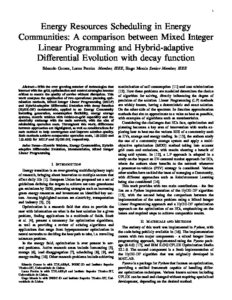
Energy Resources Scheduling in Energy Communities: A Comparison Between Mixed Integer Linear Programming and Hybrid-adaptive Differential Evolution with Decay Function
Abstract
With the ever growing number of technologies that interact with the grid, optimization and control strategies become critical to ensure the quality of service without disruption. This work analyses the application of two operational planning optimization methods, Mixed Integer Linear Programming (MILP) and Hybrid-adaptive Differential Evolution with decay function (HyDE-DF) metaheuristic, applied to an Energy Community including generation, consumption flexibility, energy storage systems, electric vehicles with vehicle-to-grid capability and the electricity exchange with the main network, with the aim of minimizing operation costs. Throughout this work, differences between approaches are highlighted, as well as considerations for each method to help convergence and improve solution quality. Both methods achieve comparable operation costs, 159.3330 and 153.4883 for MILP and HyDE-DF, respectively.

A Computational Implementation for Creating Electric Vehicles Profiles
Abstract
The need to achieve carbon neutrality has boosted the mass adoption of electric vehicles (EVs). However, the electric mobility demand uncertainty can create several technical issues in the power system management and operation. This paper presents a computational implementation based on different probability distributions for creating EVs charging profiles. Initially, aspects related to trips, EVs characteristics, and user profiles are considered as inputs to be used to define the EVs profiles. Then, in the second step, the processing of the inputs aiming to obtain information such as trips during the day, types of EVs, user profiles, trips by users, trip duration, and energy needs are considered. The proposed case studies demonstrate the effectiveness of the computational implementation since the EV profiles created taking into account different numbers of EVs show reliable information related to the EV charging profiles and charging station usage for different days of simulation (weekdays and a weekend).
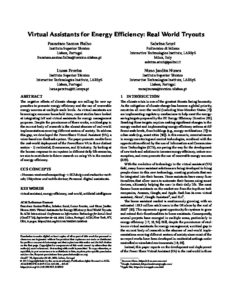
Virtual Assistants for Energy Efficiency: Real World Tryouts
Abstract
The negative effects of climate change are calling for new approaches to promote energy efficiency and the use of renewable energy sources at multiple scale levels. As virtual assistants are becoming a common household item, recent studies have looked at integrating IoT and virtual assistants for energy management purposes. Despite the prominence of these works, a critical gap in the current body of research is the almost absence of real-world implementations covering different sectors of society. To address this gap, we developed the PowerShare Virtual Assistant (VA), a voice-based eco-feedback system. The paper presents results from the real-world deployment of the PowerShare VA in three distinct sectors – 1) residential, 2) commerce, and 3) industry. By looking at the human response to our system in different daily life scenarios, we aim to contribute to future research on using VA in the context of energy efficiency.
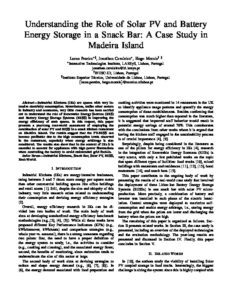
Understanding the Role of Solar PV and Battery Energy Storage in a Snack Bar: A Case Study in Madeira Island
Abstract
Industrial Kitchens (IKs) are spaces with very intensive electricity consumption. Nevertheless, unlike other sectors in industry and commerce, very little research has been carried out to understand the role of Renewable Energy Sources (RES) and Battery Energy Storage Systems (BESS) in improving the energy efficiency of such spaces. In this respect, this paper presents a year-long real-world assessment of employing the combination of solar PV and BESS in a small kitchen restaurant on Madeira Island. The results suggest that the PV-BESS can become profitable due to the high consumption levels observed in the restaurant, especially when energy arbitrage is also considered. The results also show that in the context of IKs it is essential to account for appliances with high power fluctuations when controlling the battery to avoid unintended grid feed-in.
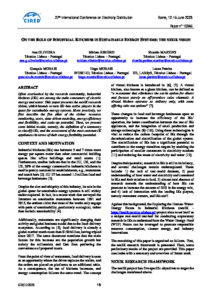
On The Role Of Industrial Kitchens In Sustainable Energy Systems: The nexIK Vision
Abstract
Often overlooked by the research community, industrial kitchens (IKs) are among the main consumers of electric energy and water. This paper presents the nexIK research vision, which intends to turn IKs into active players in the quest for sustainable energy systems. More precisely, we first describe the five pilars of the vision: resource monitoring, users, data-driven modeling, energy efficiency and flexibility, and scale-up potential. Then, we present some initial results, namely, the definition of a taxonomy to classify IKs, and the assessment of the most common IK appliances in terms of their energy flexibility potential.
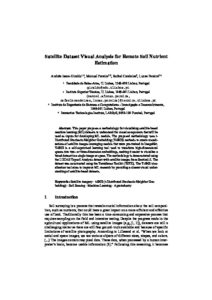
Satellite Dataset Visual Analysis for Remote Soil Nutrient Estimation
Abstract
This paper proposes a methodology for visualizing satellite-based machine learning (ML) datasets to understand the visual components that will be used as inputs for developing ML models. The proposed methodology uses t-Distributed Stochastic Neighbor Embedding (T-SNE) methods to create visualizations of satellite images leveraging models that were pre-trained in ImageNet. T-SNE is a self-supervised learning tool used to transform high-dimensional spaces into two- or three-dimension embeddings, making it easier to visualize a broad dataset in a single image or space. The methodology is demonstrated using the LUCAS Copernicus dataset with satellite images from Sentinel-2. The dataset was constructed using the TerraSense Toolkit (TSTK) and information from the LUCAS Survey, an effort of the European Soil Data Centre. The T-SNE visualization tool aims to improve ML research by providing a clearer understanding of satellite-based datasets.
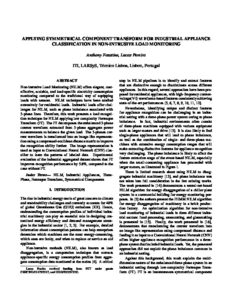
Applying Symmetrical Component Transform for Industrial Appliance Classification in Non-Intrusive Load Monitoring
Abstract
Non-intrusive Load Monitoring (NILM) offers elegant, cost-effective, scalable, and load-specific electricity consumption monitoring compared to the traditional way of equipping loads with sensors. NILM techniques have been studied extensively for residential loads. Industrial loads offer challenges for NILM, such as phase imbalance associated with 3-phase lines. Therefore, this work presents a load recognition technique for NILM applying low complexity Fortesque Transform (FT). The FT decomposes the unbalanced 3-phase current waveform extracted from 3-phase aggregate power measurements to balance the given load. The 3-phases current waveform is transformed into an image-like representation using a compressed-euclidean distance matrix to improve the recognition ability further. The image representation is used as input to Convolutional Neural Network (CNN) classifier to learn the patterns of labeled data. Experimental evaluation of the industrial aggregated dataset shows that FT improves recognition performance by 5.8\%, compared to the case without FT.
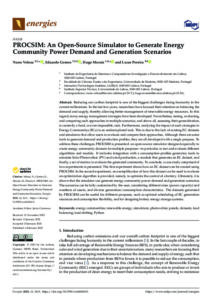
PROCSIM: An Open-Source Simulator to Generate Energy Community Power Demand and Generation Scenarios
Abstract
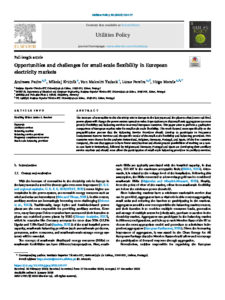
Opportunities and Challenges for Small-Scale Flexibility in European Electricity Markets
Abstract
The increase of renewables in the electricity mix in Europe in the last years and the plans to shut down coal-fired power plants will change the power system operation rules. Expectations are that small unit aggregators can soon provide flexibility and balancing services in several European countries. This paper aims to perform a qualitative comparison of European market rules for small-scale-scale flexibility. The work focused more specifically on the prequalification process that the Balancing Service Providers should develop to participate in Frequency Containment Reserve Services and the specific needs of the small-scale flexibility and balancing providers. Five countries were chosen for the analysis: Switzerland, Belgium, Germany, Portugal, and Spain. Of the five countries compared, the one that appears to have fewer entry barriers and shows greater possibilities of working on a case-to-case basis is Switzerland, followed by Belgium and Germany. Portugal and Spain are developing their ancillary service markets and should soon allow the participation of small-scale balancing providers in ancillary services.
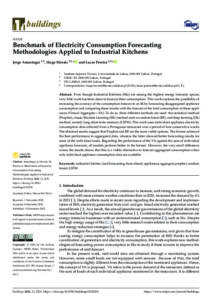
Benchmark of Electricity Consumption Forecasting Methodologies Applied to Industrial Kitchens
Abstract
Even though Industrial Kitchens (IKs) are among the highest energy intensity spaces, very little work has been done to forecast their consumption. This work explores the possibility of increasing the accuracy of the consumption forecast in an IK by forecasting disaggregated appliance consumption and comparing these results with the forecast of the total consumption of these appliances (Virtual Aggregate—VA). To do so, three different methods are used: the statistical method (Prophet), classic Machine Learning (ML) method such as random forest (RF), and deep learning (DL) method, namely long short-term memory (LSTM). This work uses individual appliance electricity consumption data collected from a Portuguese restaurant over a period of four consecutive weeks. The obtained results suggest that Prophet and RF are the more viable options. The former achieved the best performance in aggregated data, whereas the latter showed better forecasting results for most of the individual loads. Regarding the performance of the VA against the sum of individual appliance forecasts, all models perform better in the former. However, the very small difference across the results shows that this is a viable alternative to forecast aggregated consumption when only individual appliance consumption data are available.
Improving accuracy and convergence of federated learning edge computing methods for generalized DER forecasting applications in power grid
Abstract
This proposal aims to develop more accurate federated learning (FL) methods with faster convergence properties and lower communication requirements, specifically for forecasting distributed energy resources (DER) such as renewables, energy storage, and loads in modern, low-carbon power grids. This will be achieved by (i) leveraging recently developed extensions of FL such as hierarchical and iterative clustering to improve performance with non-IID data, (ii) experimenting with different types of FL global models well-suited to time-series data, and (iii) incorporating domain-specific knowledge from power systems to build more general FL frameworks and architectures that can be applied to diverse types of DERs beyond just load forecasting, and with heterogeneous clients.
Interpretable Spatiotemporal Forecasting of Arctic Sea Ice Concentration at Seasonal Lead Times
Abstract
There are many benefits from the accurate forecasting of Arctic sea ice, however existing models struggle to reliably predict sea ice concentration at long lead times. Many numerical models exist but can be sensitive to initial conditions, and while recent deep learning-based methods improve overall robustness, they either do not utilize temporal trends or rely on architectures that are not performant at learning long-term sequential dependencies. We propose a method of forecasting sea ice concentration using neural circuit policies, a form of continuous time recurrent neural architecture, which improve the learning of long-term sequential dependencies compared to existing techniques and offer the added benefits of adaptability to irregular sequence intervals and high interpretability.
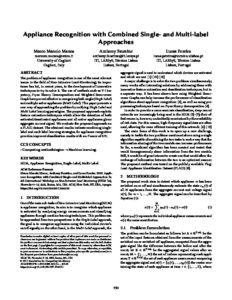
Appliance Recognition with Combined Single- and Multi-label Approaches
Abstract:
The problem of appliance recognition is one of the most relevant issues in the field of Non-Intrusive-Load-Monitoring; its importance has led, in recent years, to the development of innovative techniques to try to solve it. The use of methods such as V-I trajectory, Fryze Theory Decomposition, and Weighted Recurrence Graph have proved effective in recognizing both single (Single Label) and multiple active appliances (Multi-Label). This paper presents a new way of approaching the problem by unifying Single Label and Multi-Label learning paradigms. The proposed approach exploits feature extraction techniques that allow the detection of both activated/deactivated appliances and all active appliances given aggregate current signal. We evaluate the proposed approach on a PLAID dataset. The obtained results indicate combining single-label and multi-label learning strategies for appliance recognition provides improved classification results with an F-score of 0.91.
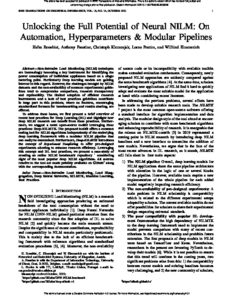
Unlocking the Full Potential of Neural NILM: On Automation, Hyperparameters & Modular Pipelines
Abstract
Non-Intrusive Load Monitoring (NILM) techniques are increasingly becoming a key instrument for identifying the power consumption of individual appliances based on a single metering point. Particularly Deep learning models are gaining interest in this regard. However, the challenges brought by NILM datasets and the non-availability of common experimental guidelines tend to compromise comparison, research transparency, and replicability. The limited adoption of efficient research instruments and a lack of best practices guidelines contribute in huge part to this problem, where no features, encouraging standardized formats for benchmarking and results sharing, are offered. To address these issues, we first present a brief overview of recent best practices for Deep Learning (DL) and highlight how deep NILM research can benefit from these practices. Furthermore, we suggest a novel open-source toolkit leveraging these practices: Deep-NILMTK. The proposed toolkit offers a common testing bed for NILM algorithms independently of the underlying deep learning framework with a modular NILM pipeline that can easily be customized. Furthermore, Deep-NILMTK introduces the concept of Experiment Templating to offer pre-designed experiments allowing to enhance research efficiency. Leveraging this concept and DL best practices, we present a case study of creating an online NILM benchmark repository.
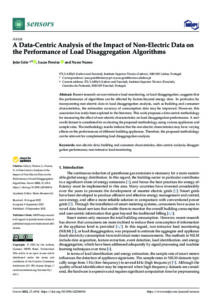
A Data-Centric Analysis of the Impact of Non-Electric Data on the Performance of Load Disaggregation Algorithms
Abstract
Recent research on non-intrusive load monitoring, or load disaggregation, suggests that the performance of algorithms can be affected by factors beyond energy data. In particular, by incorporating non-electric data in load disaggregation analysis, such as building and consumer characteristics, the estimation accuracy of consumption data may be improved. However, this association has rarely been explored in the literature. This work proposes a data-centric methodology for measuring the effect of non-electric characteristics on load disaggregation performance. A real-world dataset is considered for evaluating the proposed methodology, using various appliances and sample rates. The methodology results indicate that the non-electric characteristics may have varying effects on the performances of different building appliances. Therefore, the proposed methodology can be relevant for complementing load disaggregation analysis.
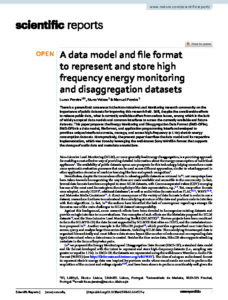
A Data Model and File Format to Represent and Store High Frequency Energy Monitoring and Disaggregation Datasets
Abstract
There is a generalized consensus in the Non-Intrusive Load Monitoring research community on the importance of public datasets for improving this research field. Still, despite the considerable efforts to release public data, what is currently available suffers from serious issues, among which is the lack of widely accepted data models and common interfaces to access the currently available and future datasets. This paper proposes the Energy Monitoring and Disaggregation Data Format (EMD-DF64). EMD-DF64 is a data model, file format, and application programming interface developed to provide a unique interface to create, manage, and access high-frequency (>=1Hz) electric energy consumption datasets. More precisely, the present paper describes the data model and its respective implementation, which was done by leveraging the well-known Sony WAVE64 format that supports the storage of audio data and metadata annotations.
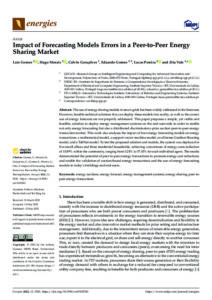
Impact of Forecasting Models Errors in a Peer-to-Peer Energy Sharing Market
Abstract
The use of energy sharing models in smart grids has been widely addressed in the literature. However, feasible technical solutions that can deploy these models into reality, as well as the correct use of energy forecasts are not properly addressed. This paper proposes a simple, yet viable and feasible, solution to deploy energy management systems on the end-user-side in order to enable not only energy forecasting but also a distributed discriminatory-price auction peer-to-peer energy transaction market. This work also analyses the impact of four energy forecasting models on energy transactions: a mathematical model, a support vector machine model, an eXtreme Gradient Boosting model, and a TabNet model. To test the proposed solution and models, the system was deployed in five small offices and three residential households, achieving a maximum energy costs reduction of 10.89% within the community, ranging from 0.24% to 57.43% for each individual agent. The results demonstrated the potential of peer-to-peer energy transactions to promote energy cost reductions and enable the validation of auction-based energy transactions and the use of energy forecasting models in today’s buildings and end-users.
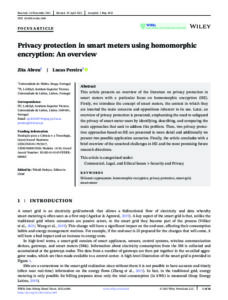
Privacy Protection in Smart Meters using Homomorphic Encryption: an overview
Abstract
This paper presents an overview of the literature on privacy protection in smart meters with a particular focus on Homomorphic Encryption (HE). Firstly, we introduce the concept of smart meters, the context in which they are inserted, the main concerns, and oppositions inherent to their use. Later,}an overview of privacy protection is presented, emphasizing the need to safeguard the privacy of smart-meter users by identifying, describing, and comparing the main approaches that seek to address this problem. Then, two privacy protection approaches based on HE are presented in more detail and additionally we present two possible application scenarios. Finally, the paper concludes with a brief overview of the unsolved challenges in HE and the most promising future research directions.
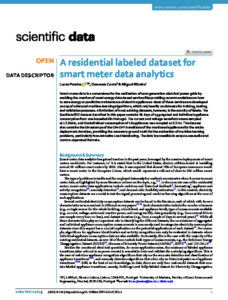
A Residential Labeled Dataset for Smart Meter Data Analytics
Abstract
Smart meter data is a cornerstone for the realization of next-generation electrical power grids by enabling the creation of novel energy data-based services like providing recommendations on how to save energy or predictive maintenance of electric appliances. Most of these services are developed on top of advanced machine-learning algorithms, which rely heavily on datasets for training, testing, and validation purposes. A limitation of most existing datasets, however, is the scarcity of labels. The SustDataED2 dataset described in this paper contains 96 days of aggregated and individual appliance consumption from one household in Portugal. The current and voltage waveforms were sampled at 12.8 kHz, and the individual consumption of 18 appliances was sampled at 0.5 Hz. The dataset also contains the timestamps of the ON-OFF transitions of the monitored appliances for the entire deployment duration, providing the necessary ground truth for the evaluation of machine learning problems, particularly Non-Intrusive Load Monitoring. The data is accessible in easy-to-use audio and comma-separated formats.
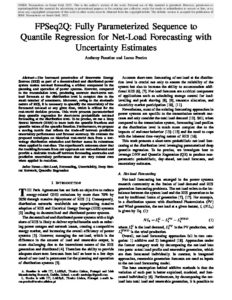
FPSeq2Q: Fully Parameterized Sequence to Quantile Regression for Net-Load Forecasting with Uncertainty Estimates
Abstract
The increased penetration of Renewable Energy Sources (RES) as part of a decentralized and distributed power system makes net-load forecasting a critical component in the planning and operation of power systems. However, compared to the transmission level, producing accurate short-term net-load forecasts at the distribution level is complex due to the small number of consumers. Moreover, owing to the stochastic nature of RES, it is necessary to quantify the uncertainty of the forecasted net-load at any given time, which is critical for the real-world decision process. This work presents parameterized deep quantile regression for short-term probabilistic net-load forecasting at the distribution level. To be precise, we use a Deep Neural Network (DNN) to learn both the quantile fractions and quantile values of the quantile function. Furthermore, we propose a scoring metric that reflects the trade-off between predictive uncertainty performance and forecast accuracy. We evaluate the proposed techniques on historical real-world data from a low-voltage distribution substation and further assess its robustness when applied in real-time. The experiment’s outcomes show that the resulting forecasts from our approach are well-calibrated and provide a desirable trade-off between forecasting accuracies and predictive uncertainty performance that are very robust even when applied in real-time.
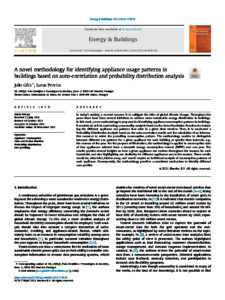
A Novel Methodology for Identifying Appliance Usage Patterns in Buildings Based on Auto-Correlation and Probability Distribution Analysis
Abstract
In today’s society, a current concern is to mitigate the risks of global climate change. Throughout the years there have been several initiatives to achieve more sustainable energy distribution in buildings. In this work, a new methodology is proposed for identifying appliance consumption patterns in buildings. It consists of, at first, conducting a seasonality analysis based on the Auto-Correlation Function for detecting the different appliance use patterns that arise in a given time window. Then, it is conducted a Probability Distribution Analysis based on the auto-correlation results and the calculation of an informative measure to select the prevailing consumption pattern. The methodology enables to distinguish between different use patterns for a given appliance for each building at specific time intervals, e.g., the seasons of the year. For the purpose of illustration, the methodology is applied to consumption data of four appliances selected from a domestic energy consumption dataset (REFIT) over one year. The results provide several insights on how a given appliance use evolves throughout the seasons for each household, and also highlighting use similarity for different appliances across the seasons. These results would be, otherwise, hidden away, and would require an individual analysis of consumption patterns of each appliance. Consequently, the methodology provides a consistent mechanism to identify different user profiles.
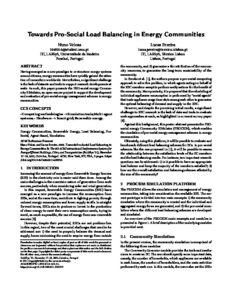
Towards Pro-Social Load Balancing in Energy Communities
Abstract
Having emerged as a new paradigm to re-structure energy systems around citizens, energy communities have quickly gained the attention of researchers worldwide. Nevertheless, a significant challenge is the lack of datasets and tools to support research developments at scale. As such, this paper presents the PRO-social energy Community SIMulator, an open-source project to support the development and evaluation of pro-social energy management schemes in energy communities.
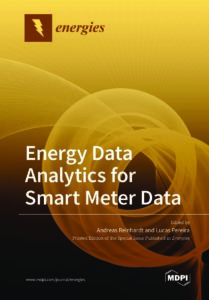
Energy Data Analytics for Smart Meter Data
Preface to ”Energy Data Analytics for Smart Meter Data”
The roll-out of smart electricity meters is a cornerstone for the realization of next-generation electrical power grids. In addition to measuring electrical consumption data at much greater temporal and amplitude resolutions than offered by traditional metering devices, smart meters can communicate collected data to external service providers and thus enable the creation of novel energy data-based services that extend far beyond their usage for billing purposes. These include, but are not limited to, the enablement of ambient-assisted living, generation, and demand forecasting, or the provision of recommendations on how to save energy.
A fundamental research challenge, still unresolved today, is how to fully explore and exploit the information content of smart meter data. This is a challenge pertaining not only to data processing but equally to their collection, transmission, and ensuring the appropriate security and privacy protection.
This book includes twelve research works and two review papers covering the entire lifecycle of smart meter data. The first set of contributions is centered around providing new solutions to the processing of smart meter data. These include innovative approaches for non-intrusive load monitoring (NILM) and the identification of electricity theft, exploiting novel techniques, and partially based on parameters beyond smart meter data alone. These contributions are followed by novel approaches to other data-driven services, including the privacy-preserving collection and synthetic generation of electricity consumption data. Two review papers cover the most up-to-date research efforts in deep learning for NILM, as well as a survey of viable options to streamline the provision of smart meter data applications from a consumer-centric perspective.
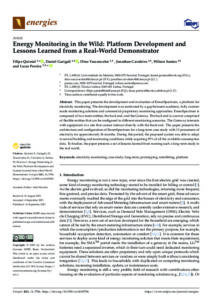
Energy Monitoring in the Wild: platform development and lessons learned from a real-world demonstrator
Abstract
This paper presents the development and evaluation of EnnerSpectrum, a platform for electricity monitoring. The development was motivated by a gap between academic, fully custom-made monitoring solutions and commercial proprietary monitoring approaches. EnnerSpectrum is composed of two main entities, the back end, and the Gateway. The back end is a server comprised of flexible entities that can be configured to different monitoring scenarios. The Gateway interacts with equipment at a site that cannot interact directly with the back end. The paper presents the architecture and configuration of EnnerSpectrum for a long-term case study with 13 prosumers of electricity for approximately 36 months. During this period, the proposed system was able to adapt to several building and monitoring conditions while acquiring 95% of all the available consumption data. To finalize, the paper presents a set of lessons learned from running such a long-term study in the real world.
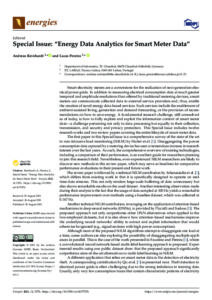
Special Issue: Energy Data Analytics for Smart Meter Data
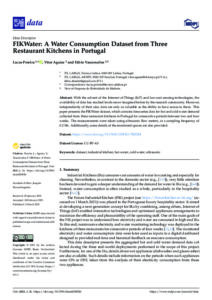
FIKWater: A Water Consumption Dataset from Three Restaurant Kitchens in Portugal
Abstract
With the advent of IoT and low-cost sensing technologies, the availability of data has reached levels never imagined before by the research community. However, independently of its size, data is only as valuable as the ability to have access to it. This paper presents the FIKWater dataset, which contains time series data for hot and cold water demand collected from three restaurant kitchens in Portugal for consecutive periods between two and four weeks. The measurements were taken using ultrasonic flow meters, at a sampling frequency of 15Hz. Additionally, some details of the monitored spaces are also provided.
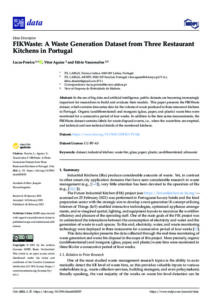
FIKWaste: A Waste Generation Dataset from Three Restaurant Kitchens in Portugal
Abstract
In the era of big data and artificial intelligence, public datasets are becoming increasingly important for researchers to build and evaluate their models. This paper presents the FIKWaste dataset, which contains time series data for the volume of waste produced in three restaurant kitchens in Portugal. Glass, paper, plastic, and undifferentiated waste bins were monitored for consecutive periods of four weeks. In addition to the time-series measurements, the FIKWaste dataset contains labels for waste disposal events, i.e., when the waste bins are emptied, and technical and non-technical details of the monitored kitchens.
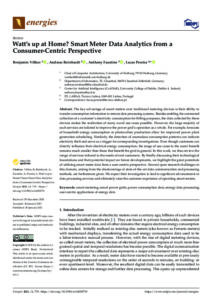
Watt’s up at Home? Smart Meter Data Analytics from a Consumer-Centric Perspective
Abstract
The key advantage of smart meters over traditional metering devices is their ability to transfer consumption information to remote data processing systems. Besides enabling the automated collection of a customer’s electricity consumption for billing purposes, the data collected by these devices makes the realization of many novel use cases possible.
However, the large majority of such services are tailored to improve the power grid’s operation as a whole.
For example, forecasts of household energy consumption or photovoltaic production allow for improved power plant generation scheduling. Similarly, the detection of anomalous consumption patterns can indicate electricity theft and serve as a trigger for corresponding investigations. Even though customers can directly influence their electrical energy consumption, the range of use cases to the users’ benefit remains much smaller than those that benefit the grid in general.
In this work, we thus review the range of services tailored to the needs of end-customers. By briefly discussing their technological foundations and their potential impact on future developments, we highlight the great potentials of utilizing smart meter data from a user-centric perspective. Several open research challenges in this domain, arising from the shortcomings of state-of-the-art data communication and processing methods, are furthermore given. We expect their investigation to lead to significant advancements in data processing services and ultimately raise the customer experience of operating smart meters.
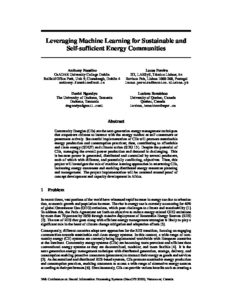
Leveraging Machine Learning for Sustainable and Self-sufficient Energy Communities
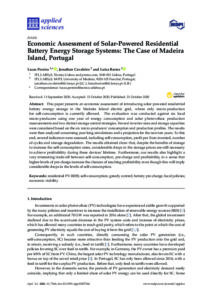
Economic Assessment of Solar-Powered Residential Battery Energy Storage Systems: the case of Madeira Island, Portugal
Abstract
This paper presents an economic assessment of introducing solar-powered residential battery energy storage in the Madeira Island electric grid, where only micro-production for self-consumption is currently allowed. The evaluation was conducted against six local micro-producers using one year of energy consumption and solar photovoltaic production measurements and two distinct storage control strategies. Several inverter sizes and storage capacities were considered based on the six micro-producers’ consumption and production profiles. The results were then analyzed concerning year-long simulations and a projection for the next ten years. To this end, several indicators were assessed, including self-consumption, profit per Euro invested, number of cycles, and storage degradation. The results obtained show that despite the benefits of storage to increase the self-consumption rates, considerable drops in the storage prices are still necessary to achieve profitability during these devices’ lifetime. Furthermore, our results also highlight a very interesting trade-off between self-consumption, pre-charge, and profitability, in a sense that higher levels of pre-charge increase the chances of reaching profitability even though this will imply considerable drops in the levels of self-consumption.
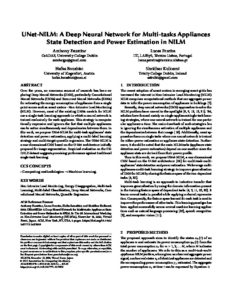
UNet-NILM: A Deep Neural Network for Multi-tasks Appliances State Detection and Power Estimation in NILM
Abstract
Over the years, an enormous amount of research has been exploring Deep Neural Networks (DNN), particularly Convolutional Neural Networks (CNNs) and Recurrent Neural Networks (RNNs) for estimating the energy consumption of appliances from a single point source such as smart meters – Non-Intrusive Load Monitoring (NILM).
However, most of the existing DNNs models for NILM use a single-task learning approach in which a neural network is trained exclusively for each appliance. This strategy is computationally expensive and ignores the fact that multiple appliances can be active simultaneously and dependencies between them. In this work, we propose UNet-NILM for multi-task appliances’ state detection and power estimation, applying a multi-label learning strategy and multi-target quantile regression. The UNet-NILM is a one-dimensional CNN based on the U-Net architecture initially proposed for image segmentation. Empirical evaluation on the UKDALE dataset suggests promising performance against traditional single-task learning.

On the Relationship between Seasons of the Year and Disaggregation Performance
Abstract
This paper pursues the question of how seasons of the year affect disaggregation performance in Non-Intrusive Load Monitoring.
To this end, we select the dishwasher, a common household appliance that may exhibit usage cycles depending on the user. We utilize an auto-correlation function to detect usage patterns of dishwashers in each season. Then, we examine the dissimilarity across each season with the help of the Keogh Lower Bound measure. Finally, we conduct a disaggregation study using the REFIT dataset and relate the outcome to the dissimilarity across seasons. Our findings indicate that in cases where energy consumption shows similarity throughout seasons, the performance of load disaggregation approaches can be positively affected.
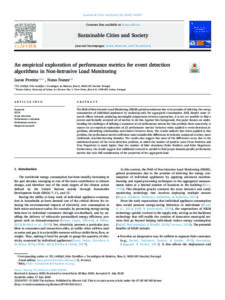
An Empirical Exploration of Performance Metrics for Event Detection Algorithms in Non-Intrusive Load Monitoring
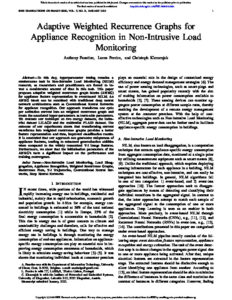
Adaptive Weighted Recurrence Graphs for Appliance Recognition in Non-Intrusive Load Monitoring
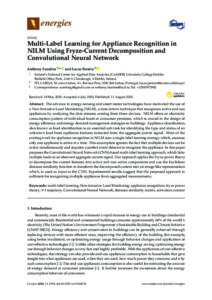
Multi-label Learning for Appliance Recognition in NILM using Fryze-Current Decomposition and Convolutional Neural Network
Abstract
The advance in energy-sensing and smart-meter technologies have motivated the use of a Non-Intrusive Load Monitoring (NILM), a data-driven technique that recognizes active end-use appliances by analyzing the data streams coming from these devices. NILM offers an electricity consumption pattern of individual loads at consumer premises, which is crucial in the design of energy efficiency and energy demand management strategies in buildings. Appliance classification, also known as load identification is an essential sub-task for identifying the type and status of an unknown load from appliance features extracted from the aggregate power signal. Most of the existing work for appliance recognition in NILM uses a single-label learning strategy which, assumes only one appliance is active at a time. This assumption ignores the fact that multiple devices can be active simultaneously and requires a perfect event detector to recognize the appliance. In this paper proposes the Convolutional Neural Network (CNN)-based multi-label learning approach, which links multiple loads to an observed aggregate current signal. Our approach applies the Fryze power theory to decompose the current features into active and non-active components and use the Euclidean distance similarity function to transform the decomposed current into an image-like representation which, is used as input to the CNN. Experimental results suggest that the proposed approach is sufficient for recognizing multiple appliances from aggregated measurements.
Resources
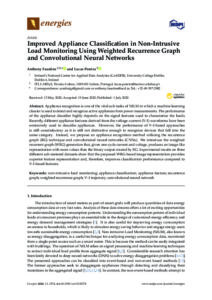
Improved Appliance Classification in Non-Intrusive Load Monitoring Using Weighted Recurrence Graph and Convolutional Neural Networks
Abstract
Appliance recognition is one of the vital sub-tasks of NILM in which a machine learning classier is used to detect and recognize active appliances from power measurements. The performance of the appliance classifier highly depends on the signal features used to characterize the loads. Recently, different appliance features derived from the voltage–current (V–I) waveforms have been extensively used to describe appliances. However, the performance of V–I-based approaches is still unsatisfactory as it is still not distinctive enough to recognize devices that fall into the same category. Instead, we propose an appliance recognition method utilizing the recurrence graph (RG) technique and convolutional neural networks (CNNs). We introduce the weighted recurrent graph (WRG) generation that, given one-cycle current and voltage, produces an image-like representation with more values than the binary output created by RG. Experimental results on three different sub-metered datasets show that the proposed WRG-based image representation provides superior feature representation and, therefore, improves classification performance compared to V–I-based features.
Resources
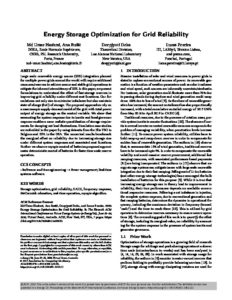
Energy Storage Optimization for Grid Reliability
Abstract
Large scale renewable energy source (RES) integration planned for multiple power grids around the world will require additional resources/reserves to achieve secure and stable grid operations to mitigate the inherent intermittency of RES. In this paper, we present formulations to understand the effect of fast storage reserves in improving grid reliability under different cost functions. Our formulations not only aim to minimize imbalance but also maintain state-of-charge (SoC) of storage. The proposed approaches rely on a macroscopic supply-demand model of the grid with total power output of energy storage as the control variable. We show that accounting for system response due to inertia and local governor response enables a more realistic quantification of storage requirements for damping net load fluctuations. Simulation case studies are embedded in the paper by using datasets from the Elia TSO in Belgium and BPA in the USA. The numerical results benchmark the marginal effect on reliability due to increasing storage size under different system responses and associated cost functions. Further we observe myopic control of batteries proposed approximates deterministic control of batteries for faster time scale reserve operation.
Resources
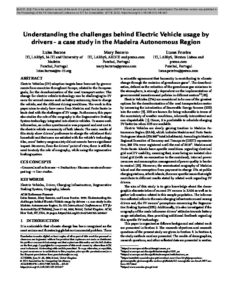
Understanding the challenges behind Electric Vehicle usage by drivers - a case study in the Madeira Autonomous Region
Abstract
Electric Vehicles (EV) adoption targets have been set by governments from countries throughout Europe, related to the European goals, for the decarbonization of the road transport sector. The change for electric vehicle technology can be challenging to EV users for several reasons such as battery autonomy, time to charge the vehicle, and the different driving conditions. The work in this paper aims to study how users from Madeira and Porto Santo islands deal with the challenges of EV usage. Furthermore, this paper also studies the role of the orography in the Regenerative Braking System technology integrated into electric vehicles. To assess such information, an online questionnaire was prepared and sent out to the electric vehicle community of both islands.
The main results of this study show drivers’ preference to charge the vehicles at their household and that users are satisfied with the vehicle’s technology. Also, users’ battery range anxiety did not seem to have a significant impact. Moreover, from the drivers’ point of view, there is still the need to study the role of orography, while using the regenerative braking system.
Resources
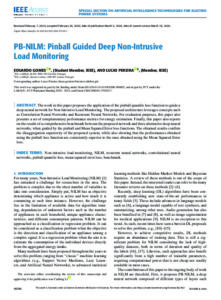
PB-NILM: PinBall Guided Deep Non-Intrusive Load Monitoring
Abstract
The work in this paper proposes the application of the pinball quantile loss function to guide a deep neural network for Non-Intrusive Load Monitoring. The proposed architecture leverages concepts such as Convolution Neural Networks and Recurrent Neural Networks. For evaluation purposes, this paper also presents a set of complementary performance metrics for energy estimation. Finally, this paper also reports on the results of a comprehensive benchmark between the proposed network and three alternative deep neural networks, when guided by the pinball and Mean Squared Error loss functions. The obtained results confirm the disaggregation superiority of the proposed system, while also showing that the performances obtained using the pinball loss function are consistently superior to the ones obtained using the Mean Squared Error loss.
Resources
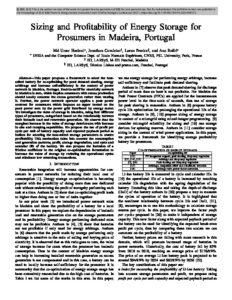
Sizing and Profitability of Energy Storage for Prosumers in Madeira, Portugal
Abstract
This paper proposes a framework to select the best-suited battery for co-optimizing for peak demand shaving, energy arbitrage and increase self-sufficiency in the context of power network in Madeira, Portugal. Feed-in-tariff for electricity network in Madeira is zero, which implies consumers with excess production should locally consume the excess generation rather than wasting it. Further, the power network {operator} applies a peak power contract for consumers which imposes an upper bound on the peak power seen by the power grid interfaced by energy meter. We investigate the value of storage in Madeira, using four different types of prosumers, categorized based on the relationship between their inelastic load and renewable generation. We observe that the marginal increase in the value of storage deteriorates with increase in size and ramping capabilities. We propose the use of profit per cycle per unit of battery capacity and expected payback period as indices for selecting the best-suited storage parameters to ensure profitability. This mechanism takes into account the consumption and generation patterns, profit, storage degradation, and cycle and calendar life of the battery. We also propose the inclusion of a friction coefficient in the original co-optimization formulation to increase the value of storage by reducing the operational cycles and eliminate low returning transactions.
Poster
Resources
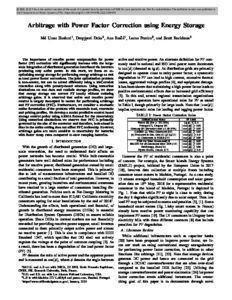
Arbitrage with Power Factor Correction using Energy Storage
Abstract
The importance of reactive power compensation for power factor (PF) correction will significantly increase with the large-scale integration of distributed generation interfaced via inverters producing only active power. In this work, we focus on co-optimizing energy storage for performing energy arbitrage as well as local power factor correction. The joint optimization problem is non-convex, but can be solved efficiently using a McCormick relaxation along with penalty-based schemes. Using numerical simulations on real data and realistic storage profiles, we show that energy storage can correct PF locally without reducing arbitrage profit. It is observed that active and reactive power control is largely decoupled in nature for performing arbitrage and PF correction (PFC). Furthermore, we consider a real-time implementation of the problem with uncertain load, renewable and pricing profiles. We develop a model predictive control based storage control policy using auto-regressive forecast for the uncertainty. We observe that PFC is primarily governed by the size of the converter and therefore, look-ahead in time in the online setting does not affect PFC noticeably. However, arbitrage profit is more sensitive to uncertainty for batteries with faster ramp rates compared to slow ramping batteries.
Resources
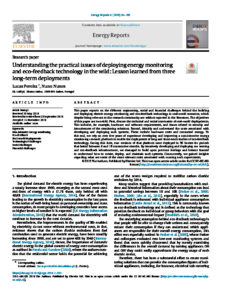
Understanding the practical issues of deploying energy monitoring and eco-feedback technology in the wild: Lesson learned from three long-term deployments
Abstract
This paper reports on the different engineering, social and financial challenges behind the building and deploying electric energy monitoring and eco-feedback technology in real-world scenarios, which despite being relevant to the research community are seldom reported in the literature. The objectives of this paper are two-fold: First, discuss the technical and social constraints of real-world deployments. This includes, for example, hardware and software requirements, and issues related to security and intrusiveness of the monitoring solutions. Second, identify and understand the costs associated with developing and deploying such systems. These include hardware costs and consumed energy. To this end, we rely on over five years of experience developing and improving a non-intrusive energy monitoring research platform to enable the deployment of long and short-term studies of eco-feedback technology. During this time, two versions of that platform were deployed in 50 homes for periods that lasted between 6 and 18 consecutive months. By iteratively developing and deploying our sensing and eco-feedback infrastructures, we managed to build upon previous findings and lessons learned to understand how to create, deploy, and maintain such systems. Concurrently, we gained insights regarding what are some of the most relevant costs associated with running such experiments.
Supplementary Material
Co-optimizing Energy Storage for Prosumers Using Convex Relaxations
Abstract
This paper presents a new co-optimization formulation for energy storage for performing energy arbitrage and power factor correction (PFC) in the time scale of minutes to hours, along with peak demand shaving in the time scale of a month. While the optimization problem is non-convex, we present an efficient penalty based convex relaxation to solve it. Furthermore, we provide a mechanism to increase the storage operational life by tuning the cycles of operation using a friction coefficient. To demonstrate the effectiveness of energy storage performing multiple tasks simultaneously, we present a case study with real data for a time scale of several months. We are able to show that energy storage can realistically correct power factor without significant change in either arbitrage gains or peak demand charges. We demonstrate a real-time Model Predictive Control (MPC) based implementation of the proposed formulation with AutoRegressive forecasting of net-load and electricity price. Numerical results indicate that arbitrage gains and peak demand shaving are more sensitive to parameter uncertainty for faster ramping battery compared to slower ramping batteries. However, PFC gains are insensitive to forecast inaccuracies.
Ultrasonic Waste Monitoring in the Future Industrial Kitchen
Abstract
This paper presents the initial results of ultrasonic waste monitoring during the operation of one industrial kitchen. Undifferentiated, paper and plastic waste bins were monitored, and a heuristic-based waste disposal event detector was developed and evaluated. The results show that it is possible to identify disposal events in the three waste bins. Furthermore, it is also possible to determine when paper and plastic are compressed to make additional room.
Poster
Future Industrial Kitchen: Challenges and Opportunities
Abstract
Large amounts of electricity, water, and food are used every day in Industrial Kitchens (IK). Still, very little attention has been devoted by the research community to this potential source of resource over-consumption. This abstract paper builds on the deployment of sensing technology in three IKs to present the main challenges and potential research directions towards more sustainable IKs.
Presentation Slides
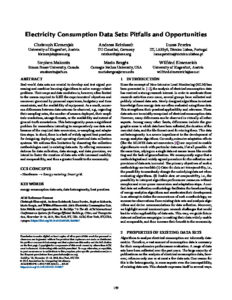
Electricity Consumption Data Sets: Pitfalls and Opportunities
Abstract
Real-world data sets are crucial to develop and test signal processing and machine learning algorithms to solve energy-related problems.
Their scope and data resolution is, however, often limited to the means required to fulfill the experimenters’ objectives and moreover governed by personal experience, budgetary and time constraints, and the availability of equipment.
As a result, numerous differences between data sets can be observed, e.g., regarding their sampling rates, the number of sensors deployed, their amplitude resolutions, storage formats, or the availability and extent of ground-truth annotations.
This heterogeneity poses a significant problem for researchers intending to comparatively use data sets because of the required data conversion, re-sampling, and adaptation steps.
In short, there is a lack of widely agreed best practices for designing, deploying, and operating electrical data collection systems.
We address this limitation by dissecting the collection methodologies used in existing data sets.
By offering recommendations for data collection, data storage, and data provision, we intend to foster the creation of data sets with increased usability and comparability, and thus a greater benefit to the community.
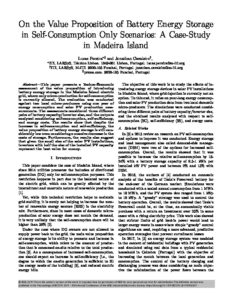
On the Value Proposition of Battery Energy Storage in Self-Consumption Only Scenarios: A Case-Study in Madeira Island
Abstract
This paper presents a Techno-Economic assessment of the value proposition of introducing battery energy storage in the Madeira Island electric grid, where only micro-production for self-consumption is currently allowed. The evaluation was conducted against two local micro-producers using one year of energy consumption and solar PV production measurements. The assessments considered three different pairs of battery capacity/inverter size, and the outputs analyzed considering self-consumption, self-sufficiency, and energy costs. The results show that despite the increase in self-consumption and self-sufficiency, the value proposition of battery energy storage is still considerably low even considering a massive decrease in the costs of storage. Furthermore, the results also suggest that given the small size of the solar PV installations, inverters with half the size of the installed PV capacity represent the best value for money.
Poster
NILMPEds: A Performance Evaluation Dataset for Event Detection Algorithms in Non-Intrusive Load Monitoring
dsCleaner: A Python Library to Clean, Preprocess and Convert Non-Intrusive Load Monitoring Datasets
The Acceptance of Energy Monitoring Technologies – The Case of Local Prosumers
Abstract
With transformations happening in the electricity sector, we need to ensure consumers have access to updated and correct information to accompany such changes. Consumers need to understand technologies available to them but also, learn how to use them to optimize their personal investment in such types of equipment. In this paper, we explore how a group of local prosumers has adopted energy monitoring technologies, their day-to-day strategies, and expectations when handling such systems. We studied 11 prosumers and the technologies they have used for three years, evaluated their satisfaction with the feedback provided and analyzed how a more modern visualization of their energy practices was introduced and adopted into their daily lives. We conducted interviews and questionnaires to evaluate their engagement with these tools. This initial work suggests this particular group of users have already a high level of knowledge about their systems, and as a result, have integrated these into their routines. However, more support would be needed from other local actors to help them reach more benefits and as such, more satisfaction as consumers. We conclude by reflecting on barriers that need to be addressed to increase user satisfaction with these systems.
Energy Storage in Madeira, Portugal: Co-optimizing for Arbitrage, Self-Sufficiency, Peak Shaving and Energy Backup
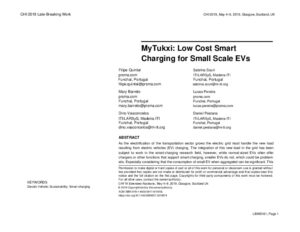
MyTukxi: Low Cost Smart Charging for Small Scale EVs
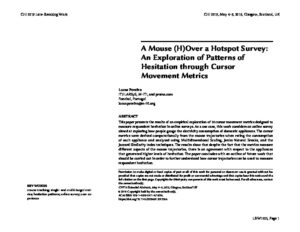
A Mouse (H)Over a Hotspot Survey: An Exploration of Patterns of Hesitation through Cursor Movement Metrics
Abstract:
This paper presents the results of an empirical exploration of 10 cursor movement metrics designed to measure respondent hesitation in online surveys. As a use case, this work considers an online survey aimed at exploring how people gauge the electricity consumption of domestic appliances. The cursor metrics were derived computationally from the mouse trajectories when rating the consumption of each appliance and analyzed using Multidimensional Scaling, Jenks Natural Breaks, and the Jaccard Similarity Index techniques. The results show that despite the fact that the metrics measure different aspects of the mouse trajectories, there is an agreement with respect to the appliances that generated higher levels of hesitation. The paper concludes with an outline of future work that should be carried out in order to further understand how cursor trajectories can be used to measure respondent hesitation.
Poster:
Reproducible Research:
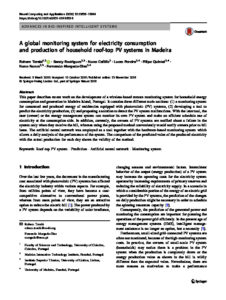
A global monitoring system for electricity consumption and production of household roof-top PV systems in Madeira
Highlights of ES2DE and IWOBI 2017: extended versions of selected best papers
Implementation Strategy of Convolution Neural Networks on Field Programmable Gate Arrays for Appliance Classification Using the Voltage and Current (V-I) Trajectory
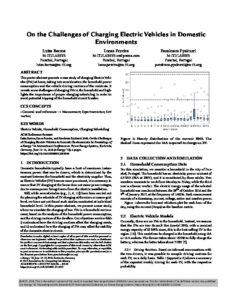
On the Challenges of Charging Electric Vehicles in Domestic Environments
Abstract
This poster abstract presents a case study of charging Electric Vehicles (EVs) at home, taking into consideration the household power consumption and the vehicle driving routines of the residents. It reveals some challenges of charging EVs in the household and highlights the importance of proper charging scheduling in order to avoid potential tripping of the household circuit breaker.
Poster
Madeira Pilot User Acceptance Report of the Initial Smart Meter Deployment
Data Collection, Modelling, Simulation and Decision
Madeira Pilot Infrastructure Preparation and Kick-off
Madeira Pilot Case Study Specification and Assessment
Proceedings of the 2017 Sustainable Internet and ICT for Sustainability (SustainIT)
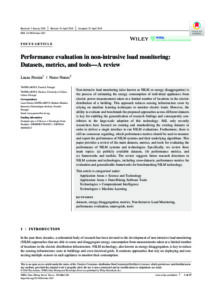
Performance Evaluation in Non-Intrusive Load Monitoring: datasets, metrics and tools - a review
Data Storage and Maintenance Challenges: The Case of Advanced Metering Infrastructure Systems
An Experimental Comparison of Performance Metrics for Event Detection Algorithms in NILM
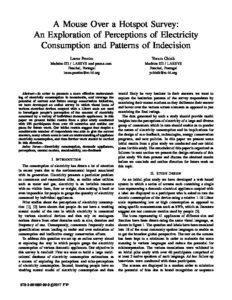
A Mouse over a Hotspot Survey: An exploration of perceptions of electricity consumption and patterns of indecision
Abstract
In order to promote a more effective understanding of electricity consumption in households, and leverage the potential of current and future energy conservation initiatives, we have developed an online survey in which visual icons of various electrical devices coupled with a Likert scale are used to investigate people’s perception of the amount of electricity consumed by a variety of individual domestic appliances. In this paper we present initial results from a pilot study conducted with 293 participants from over 50 countries and outline our plans for future work. Our initial results suggest that despite a considerable number of respondents was able to give the correct answers, many others seem to lack an understanding of appliance electricity consumption, and thus further work should be carried in this direction.
Reproducible Research:
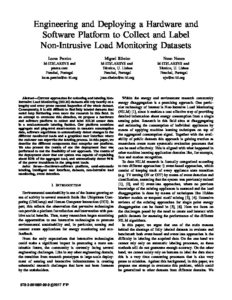
Engineering and Deploying a Hardware and Software Platform to Collect and Label Non-Intrusive Load Monitoring Datasets
Abstract
Current approaches for collecting and labeling Non- Intrusive Load Monitoring (NILM) datasets still rely heavily on a lengthy and error-prone manual inspection of the whole dataset. Consequently, it is still difficult to find fully labeled datasets that could help furthering, even more, the research in this field. In an attempt to overcome this situation, we propose a hardware and software platform to collect and label NILM sensor data in a semi-automatic labeling fashion. Our platform combines aggregate and plug-level smart-meters to measure consumption data, software algorithms to automatically detect changes in the different monitored loads and a graphical user interface where the end-user can supervise the labeling process. In this paper, we describe the different components that comprise our platform. We also present the results of one live deployment that was performed to test the feasibility of our approach. The results of the deployment show that our system was capable of explaining about 82% of the aggregate load, and automatically detect 94% of the power transitions in the plug-level loads.
Resources
Software (GitLab Repository)
Data (SustDataED Public Dataset)
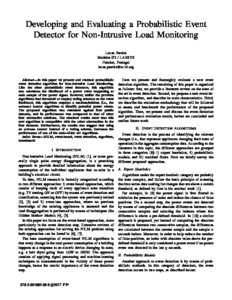
Developing and Evaluating a Probabilistic Event Detector for Non-Intrusive Load Monitoring
EMD-DF: A Data Model and File Format for Energy Monitoring and Disaggregation Datasets
A Comparison of Performance Metrics for Event Classification in Non-Intrusive Load Monitoring
SustDataED: A Public Dataset for Electric Energy Disaggregation Research
Towards using Low-Cost Opportunistic Energy Sensing for Promoting Energy Conservation
What-a-Watt: Exploring Electricity Production Literacy Through a Long Term Eco-Feedback Study
Towards Systematic Performance Evaluation of Non-Intrusive Load Monitoring Algorithms and Systems
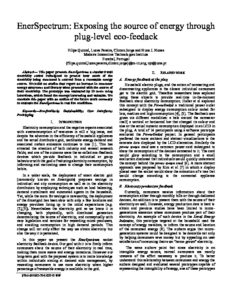
EnerSpectrum: Exposing the source of energy through plug-level eco-feedack
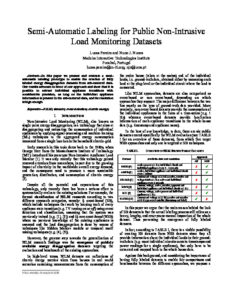
Semi-Automatic Labeling for Non-Intrusive Load Monitoring Datasets
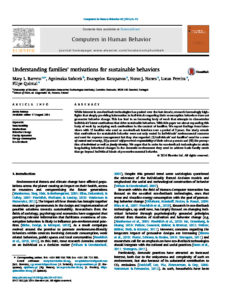
Understanding families’ motivations for sustainable behaviors
